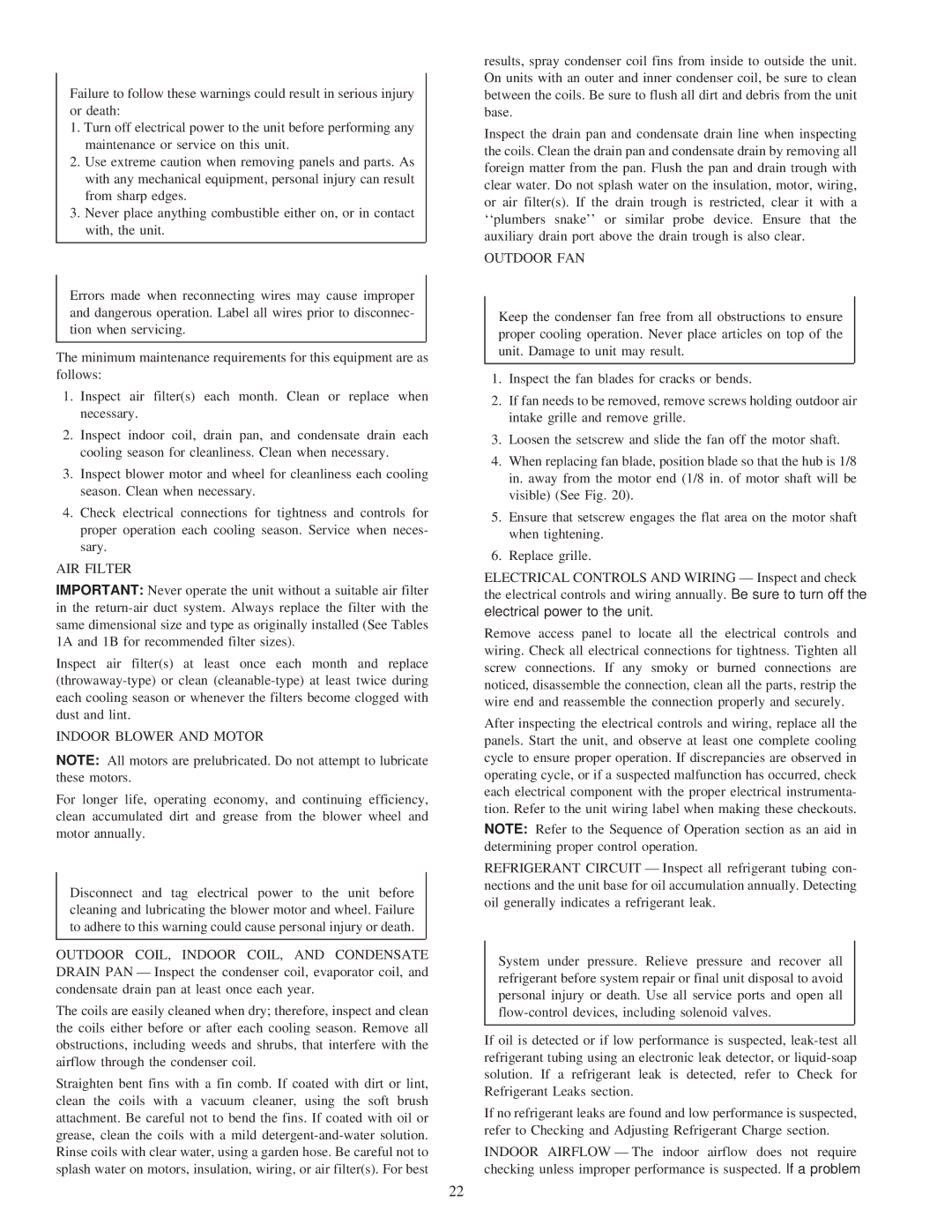Failure to follow these warnings could result in serious injury or death:
1.Turn off electrical power to the unit before performing any maintenance or service on this unit.
2.Use extreme caution when removing panels and parts. As with any mechanical equipment, personal injury can result from sharp edges.
3.Never place anything combustible either on, or in contact with, the unit.
Errors made when reconnecting wires may cause improper and dangerous operation. Label all wires prior to disconnec- tion when servicing.
The minimum maintenance requirements for this equipment are as follows:
1.Inspect air filter(s) each month. Clean or replace when necessary.
2.Inspect indoor coil, drain pan, and condensate drain each cooling season for cleanliness. Clean when necessary.
3.Inspect blower motor and wheel for cleanliness each cooling season. Clean when necessary.
4.Check electrical connections for tightness and controls for proper operation each cooling season. Service when neces- sary.
AIR FILTER
IMPORTANT: Never operate the unit without a suitable air filter in the return-air duct system. Always replace the filter with the same dimensional size and type as originally installed (See Tables 1A and 1B for recommended filter sizes).
Inspect air filter(s) at least once each month and replace (throwaway-type) or clean (cleanable-type) at least twice during each cooling season or whenever the filters become clogged with dust and lint.
INDOOR BLOWER AND MOTOR
NOTE: All motors are prelubricated. Do not attempt to lubricate these motors.
For longer life, operating economy, and continuing efficiency, clean accumulated dirt and grease from the blower wheel and motor annually.
Disconnect and tag electrical power to the unit before cleaning and lubricating the blower motor and wheel. Failure to adhere to this warning could cause personal injury or death.
OUTDOOR COIL, INDOOR COIL, AND CONDENSATE DRAIN PAN Ð Inspect the condenser coil, evaporator coil, and condensate drain pan at least once each year.
The coils are easily cleaned when dry; therefore, inspect and clean the coils either before or after each cooling season. Remove all obstructions, including weeds and shrubs, that interfere with the airflow through the condenser coil.
Straighten bent fins with a fin comb. If coated with dirt or lint, clean the coils with a vacuum cleaner, using the soft brush attachment. Be careful not to bend the fins. If coated with oil or grease, clean the coils with a mild detergent-and-water solution. Rinse coils with clear water, using a garden hose. Be careful not to splash water on motors, insulation, wiring, or air filter(s). For best
results, spray condenser coil fins from inside to outside the unit. On units with an outer and inner condenser coil, be sure to clean between the coils. Be sure to flush all dirt and debris from the unit base.
Inspect the drain pan and condensate drain line when inspecting the coils. Clean the drain pan and condensate drain by removing all foreign matter from the pan. Flush the pan and drain trough with clear water. Do not splash water on the insulation, motor, wiring, or air filter(s). If the drain trough is restricted, clear it with a ``plumbers snake'' or similar probe device. Ensure that the auxiliary drain port above the drain trough is also clear.
OUTDOOR FAN
Keep the condenser fan free from all obstructions to ensure proper cooling operation. Never place articles on top of the unit. Damage to unit may result.
1.Inspect the fan blades for cracks or bends.
2.If fan needs to be removed, remove screws holding outdoor air intake grille and remove grille.
3.Loosen the setscrew and slide the fan off the motor shaft.
4.When replacing fan blade, position blade so that the hub is 1/8 in. away from the motor end (1/8 in. of motor shaft will be visible) (See Fig. 20).
5.Ensure that setscrew engages the flat area on the motor shaft when tightening.
6.Replace grille.
ELECTRICAL CONTROLS AND WIRING Ð Inspect and check the electrical controls and wiring annually. Be sure to turn off the electrical power to the unit.
Remove access panel to locate all the electrical controls and wiring. Check all electrical connections for tightness. Tighten all screw connections. If any smoky or burned connections are noticed, disassemble the connection, clean all the parts, restrip the wire end and reassemble the connection properly and securely.
After inspecting the electrical controls and wiring, replace all the panels. Start the unit, and observe at least one complete cooling cycle to ensure proper operation. If discrepancies are observed in operating cycle, or if a suspected malfunction has occurred, check each electrical component with the proper electrical instrumenta- tion. Refer to the unit wiring label when making these checkouts.
NOTE: Refer to the Sequence of Operation section as an aid in determining proper control operation.
REFRIGERANT CIRCUIT Ð Inspect all refrigerant tubing con- nections and the unit base for oil accumulation annually. Detecting oil generally indicates a refrigerant leak.
System under pressure. Relieve pressure and recover all refrigerant before system repair or final unit disposal to avoid personal injury or death. Use all service ports and open all flow-control devices, including solenoid valves.
If oil is detected or if low performance is suspected, leak-test all refrigerant tubing using an electronic leak detector, or liquid-soap solution. If a refrigerant leak is detected, refer to Check for Refrigerant Leaks section.
If no refrigerant leaks are found and low performance is suspected, refer to Checking and Adjusting Refrigerant Charge section.
INDOOR AIRFLOW Ð The indoor airflow does not require checking unless improper performance is suspected. If a problem

